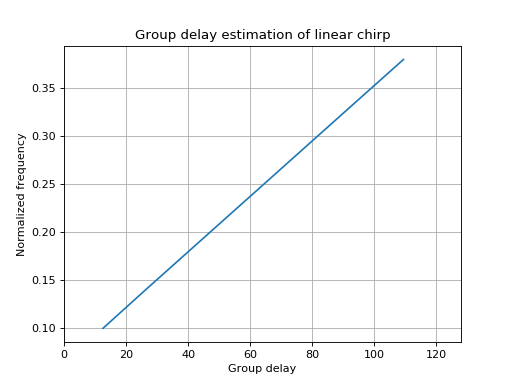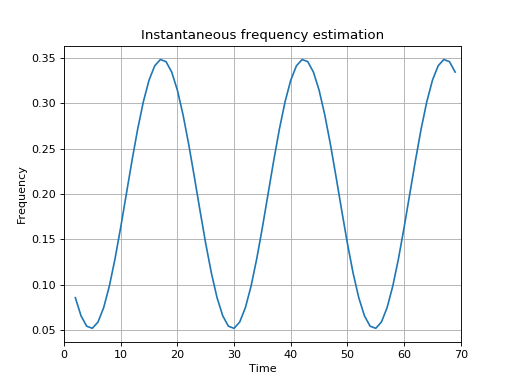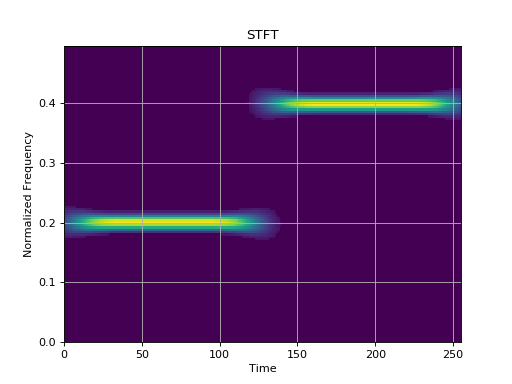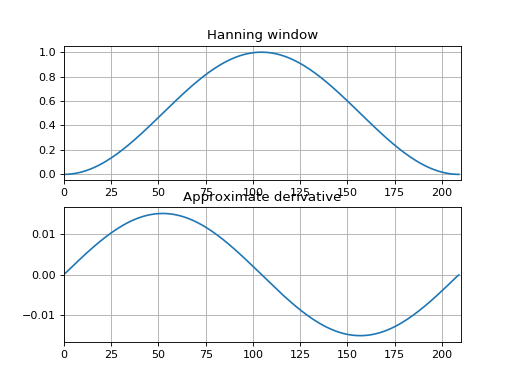tftb.processing package¶
Submodules¶
tftb.processing.affine module¶
Bilinear Time-Frequency Processing in the Affine Class.
-
class
tftb.processing.affine.AffineDistribution(signal, fmin=None, fmax=None, **kwargs)[source]¶ Bases:
tftb.processing.base.BaseTFRepresentation-
__init__(signal, fmin=None, fmax=None, **kwargs)[source]¶ Create a base time-frequency representation object.
Parameters: - signal (array-like) – Signal to be analyzed.
- **kwargs –
Other arguments required for performing the analysis.
Returns: BaseTFRepresentation object
Return type:
-
isaffine= True¶
-
plot(kind='contour', show_tf=True, threshold=0.05, **kwargs)[source]¶ Visualize the time frequency representation.
Parameters: - ax (matplotlib.axes.Axes object) – Axes object to draw the plot on.
- kind (str) – One of “cmap” (default), “contour”.
- show (bool) – Whether to call
plt.show(). - default_annotation (bool) – Whether to make default annotations for the plot. Default annotations consist of setting the X and Y axis labels to “Time” and “Normalized Frequency” respectively, and setting the title to the name of the particular time-frequency distribution.
- show_tf – Whether to show the signal and it’s spectrum alongwith
the plot. In this is True, the
axargument is ignored. - **kwargs –
Parameters to be passed to the plotting function.
Returns: None
Return type:
-
-
class
tftb.processing.affine.BertrandDistribution(signal, fmin=None, fmax=None, n_voices=None, **kwargs)[source]¶ Bases:
tftb.processing.affine.AffineDistribution-
__init__(signal, fmin=None, fmax=None, n_voices=None, **kwargs)[source]¶ Create a base time-frequency representation object.
Parameters: - signal (array-like) – Signal to be analyzed.
- **kwargs –
Other arguments required for performing the analysis.
Returns: BaseTFRepresentation object
Return type:
-
name= 'bertrand'¶
-
-
class
tftb.processing.affine.DFlandrinDistribution(signal, fmin=None, fmax=None, n_voices=None, **kwargs)[source]¶ Bases:
tftb.processing.affine.AffineDistribution-
__init__(signal, fmin=None, fmax=None, n_voices=None, **kwargs)[source]¶ Create a base time-frequency representation object.
Parameters: - signal (array-like) – Signal to be analyzed.
- **kwargs –
Other arguments required for performing the analysis.
Returns: BaseTFRepresentation object
Return type:
-
name= 'd-flandrin'¶
-
-
class
tftb.processing.affine.Scalogram(signal, fmin=None, fmax=None, n_voices=None, waveparams=None, **kwargs)[source]¶ Bases:
tftb.processing.affine.AffineDistributionMorlet Scalogram.
-
__init__(signal, fmin=None, fmax=None, n_voices=None, waveparams=None, **kwargs)[source]¶ Create a base time-frequency representation object.
Parameters: - signal (array-like) – Signal to be analyzed.
- **kwargs –
Other arguments required for performing the analysis.
Returns: BaseTFRepresentation object
Return type:
-
isaffine= False¶
-
name= 'scalogram'¶
-
-
class
tftb.processing.affine.UnterbergerDistribution(signal, form='A', fmin=None, fmax=None, n_voices=None, **kwargs)[source]¶ Bases:
tftb.processing.affine.AffineDistribution-
__init__(signal, form='A', fmin=None, fmax=None, n_voices=None, **kwargs)[source]¶ Create a base time-frequency representation object.
Parameters: - signal (array-like) – Signal to be analyzed.
- **kwargs –
Other arguments required for performing the analysis.
Returns: BaseTFRepresentation object
Return type:
-
name= 'unterberger'¶
-
tftb.processing.ambiguity module¶
Ambiguity functions.
-
tftb.processing.ambiguity.narrow_band(signal, lag=None, n_fbins=None)[source]¶ Narrow band ambiguity function.
Parameters: - signal (array-like) – Signal to be analyzed.
- lag (array-like) – vector of lag values.
- n_fbins (int) – number of frequency bins
Returns: Doppler lag representation
Return type: array-like
tftb.processing.base module¶
Base time-frequency representation class.
-
class
tftb.processing.base.BaseTFRepresentation(signal, **kwargs)[source]¶ Bases:
object-
__init__(signal, **kwargs)[source]¶ Create a base time-frequency representation object.
Parameters: - signal (array-like) – Signal to be analyzed.
- **kwargs –
Other arguments required for performing the analysis.
Returns: BaseTFRepresentation object
Return type:
-
isaffine= False¶
-
plot(ax=None, kind='cmap', show=True, default_annotation=True, show_tf=False, scale='linear', threshold=0.05, **kwargs)[source]¶ Visualize the time frequency representation.
Parameters: - ax (matplotlib.axes.Axes object) – Axes object to draw the plot on.
- kind (str) – One of “cmap” (default), “contour”.
- show (bool) – Whether to call
plt.show(). - default_annotation (bool) – Whether to make default annotations for the plot. Default annotations consist of setting the X and Y axis labels to “Time” and “Normalized Frequency” respectively, and setting the title to the name of the particular time-frequency distribution.
- show_tf – Whether to show the signal and it’s spectrum alongwith
the plot. In this is True, the
axargument is ignored. - **kwargs –
Parameters to be passed to the plotting function.
Returns: None
Return type:
-
tftb.processing.cohen module¶
Bilinear Time-Frequency Processing in the Cohen’s Class.
-
class
tftb.processing.cohen.MargenauHillDistribution(signal, **kwargs)[source]¶ Bases:
tftb.processing.base.BaseTFRepresentation-
name= 'margenau-hill'¶
-
plot(kind='cmap', threshold=0.05, sqmod=True, **kwargs)[source]¶ Visualize the time frequency representation.
Parameters: - ax (matplotlib.axes.Axes object) – Axes object to draw the plot on.
- kind (str) – One of “cmap” (default), “contour”.
- show (bool) – Whether to call
plt.show(). - default_annotation (bool) – Whether to make default annotations for the plot. Default annotations consist of setting the X and Y axis labels to “Time” and “Normalized Frequency” respectively, and setting the title to the name of the particular time-frequency distribution.
- show_tf – Whether to show the signal and it’s spectrum alongwith
the plot. In this is True, the
axargument is ignored. - **kwargs –
Parameters to be passed to the plotting function.
Returns: None
Return type:
-
-
class
tftb.processing.cohen.PageRepresentation(signal, **kwargs)[source]¶ Bases:
tftb.processing.base.BaseTFRepresentation-
name= 'page representation'¶
-
plot(kind='cmap', threshold=0.05, sqmod=True, **kwargs)[source]¶ Visualize the time frequency representation.
Parameters: - ax (matplotlib.axes.Axes object) – Axes object to draw the plot on.
- kind (str) – One of “cmap” (default), “contour”.
- show (bool) – Whether to call
plt.show(). - default_annotation (bool) – Whether to make default annotations for the plot. Default annotations consist of setting the X and Y axis labels to “Time” and “Normalized Frequency” respectively, and setting the title to the name of the particular time-frequency distribution.
- show_tf – Whether to show the signal and it’s spectrum alongwith
the plot. In this is True, the
axargument is ignored. - **kwargs –
Parameters to be passed to the plotting function.
Returns: None
Return type:
-
-
class
tftb.processing.cohen.PseudoMargenauHillDistribution(signal, **kwargs)[source]¶ Bases:
tftb.processing.cohen.MargenauHillDistribution-
name= 'pseudo margenau-hill'¶
-
-
class
tftb.processing.cohen.PseudoPageRepresentation(signal, **kwargs)[source]¶ Bases:
tftb.processing.cohen.PageRepresentation-
name= 'pseudo page'¶
-
-
class
tftb.processing.cohen.PseudoWignerVilleDistribution(signal, **kwargs)[source]¶ Bases:
tftb.processing.cohen.WignerVilleDistribution-
name= 'pseudo winger-ville'¶
-
plot(**kwargs)[source]¶ Visualize the time frequency representation.
Parameters: - ax (matplotlib.axes.Axes object) – Axes object to draw the plot on.
- kind (str) – One of “cmap” (default), “contour”.
- show (bool) – Whether to call
plt.show(). - default_annotation (bool) – Whether to make default annotations for the plot. Default annotations consist of setting the X and Y axis labels to “Time” and “Normalized Frequency” respectively, and setting the title to the name of the particular time-frequency distribution.
- show_tf – Whether to show the signal and it’s spectrum alongwith
the plot. In this is True, the
axargument is ignored. - **kwargs –
Parameters to be passed to the plotting function.
Returns: None
Return type:
-
-
class
tftb.processing.cohen.Spectrogram(signal, timestamps=None, n_fbins=None, fwindow=None)[source]¶ Bases:
tftb.processing.linear.ShortTimeFourierTransform-
name= 'spectrogram'¶
-
plot(kind='cmap', **kwargs)[source]¶ Display the spectrogram of an STFT.
Parameters: - ax (matplotlib.axes.Axes object) – axes object to draw the plot on. If None(default), one will be created.
- kind (str) – Choice of visualization type, either “cmap”(default) or “contour”.
- sqmod (bool) – Whether to take squared modulus of TFR before plotting. (Default: True)
- threshold (float) – Percentage of the maximum value of the TFR, below which all values are set to zero before plotting.
- **kwargs –
parameters passed to the plotting function.
Returns: None
Return type:
-
-
class
tftb.processing.cohen.WignerVilleDistribution(signal, **kwargs)[source]¶ Bases:
tftb.processing.base.BaseTFRepresentation-
name= 'wigner-ville'¶
-
plot(kind='cmap', threshold=0.05, sqmod=False, **kwargs)[source]¶ Visualize the time frequency representation.
Parameters: - ax (matplotlib.axes.Axes object) – Axes object to draw the plot on.
- kind (str) – One of “cmap” (default), “contour”.
- show (bool) – Whether to call
plt.show(). - default_annotation (bool) – Whether to make default annotations for the plot. Default annotations consist of setting the X and Y axis labels to “Time” and “Normalized Frequency” respectively, and setting the title to the name of the particular time-frequency distribution.
- show_tf – Whether to show the signal and it’s spectrum alongwith
the plot. In this is True, the
axargument is ignored. - **kwargs –
Parameters to be passed to the plotting function.
Returns: None
Return type:
-
-
tftb.processing.cohen.smoothed_pseudo_wigner_ville(signal, timestamps=None, freq_bins=None, twindow=None, fwindow=None)[source]¶ Smoothed Pseudo Wigner-Ville time-frequency distribution. :param signal: signal to be analyzed :param timestamps: time instants of the signal :param freq_bins: number of frequency bins :param twindow: time smoothing window :param fwindow: frequency smoothing window :type signal: array-like :type timestamps: array-like :type freq_bins: int :type twindow: array-like :type fwindow: array-like :return: Smoothed pseudo Wigner Ville distribution :rtype: array-like
tftb.processing.freq_domain module¶
-
tftb.processing.freq_domain.group_delay(x, fnorm=None)[source]¶ Compute the group delay of a signal at normalized frequencies.
Parameters: - x (numpy.ndarray) – time domain signal
- fnorm (float) – normalized frequency at which to calculate the group delay.
Returns: group delay
Return type: numpy.ndarray
Example: >>> import numpy as np >>> from tftb.generators import amgauss, fmlin >>> x = amgauss(128, 64.0, 30) * fmlin(128, 0.1, 0.4)[0] >>> fnorm = np.arange(0.1, 0.38, step=0.04) >>> gd = group_delay(x, fnorm) >>> plot(gd, fnorm) #doctest: +SKIP
(Source code, png, hires.png, pdf)

-
tftb.processing.freq_domain.inst_freq(x, t=None, L=1)[source]¶ Compute the instantaneous frequency of an analytic signal at specific time instants using the trapezoidal integration rule.
Parameters: - x (numpy.ndarray) – The input analytic signal
- t (numpy.ndarray) – The time instants at which to calculate the instantaneous frequencies.
- L (int) – Non default values are currently not supported. If L is 1, the normalized instantaneous frequency is computed. If L > 1, the maximum likelihood estimate of the instantaneous frequency of the deterministic part of the signal.
Returns: instantaneous frequencies of the input signal.
Return type: numpy.ndarray
Example: >>> from tftb.generators import fmsin >>> x = fmsin(70, 0.05, 0.35, 25)[0] >>> instf, timestamps = inst_freq(x) >>> plot(timestamps, instf) #doctest: +SKIP
(Source code, png, hires.png, pdf)

-
tftb.processing.freq_domain.locfreq(signal)[source]¶ Compute the frequency localization characteristics.
Parameters: sig (numpy.ndarray) – input signal Returns: average normalized frequency center, frequency spreading Return type: tuple Example: >>> from tftb.generators import amgauss >>> z = amgauss(160, 80, 50) >>> fm, B = locfreq(z) >>> print("%.3g" % fm) -9.18e-14 >>> print("%.4g" % B) 0.02
tftb.processing.linear module¶
Linear Time Frequency Processing.
-
class
tftb.processing.linear.ShortTimeFourierTransform(signal, timestamps=None, n_fbins=None, fwindow=None)[source]¶ Bases:
tftb.processing.base.BaseTFRepresentationShort time Fourier transform.
-
__init__(signal, timestamps=None, n_fbins=None, fwindow=None)[source]¶ Create a ShortTimeFourierTransform object.
Parameters: - signal (array-like) – Signal to be analyzed.
- timestamps (array-like) – Time instants of the signal (default:
np.arange(len(signal))) - n_fbins (int) – Number of frequency bins (default:
len(signal)) - fwindow (array-like) – Frequency smoothing window (default: Hamming window of
length
len(signal) / 4)
Returns: ShortTimeFourierTransform object
Example: >>> from tftb.generators import fmconst >>> sig = np.r_[fmconst(128, 0.2)[0], fmconst(128, 0.4)[0]] >>> stft = ShortTimeFourierTransform(sig) >>> tfr, t, f = stft.run() >>> stft.plot() #doctest: +SKIP
(Source code, png, hires.png, pdf)

-
name= 'stft'¶
-
plot(ax=None, kind='cmap', sqmod=True, threshold=0.05, **kwargs)[source]¶ Display the spectrogram of an STFT.
Parameters: - ax (matplotlib.axes.Axes object) – axes object to draw the plot on. If None(default), one will be created.
- kind (str) – Choice of visualization type, either “cmap”(default) or “contour”.
- sqmod (bool) – Whether to take squared modulus of TFR before plotting. (Default: True)
- threshold (float) – Percentage of the maximum value of the TFR, below which all values are set to zero before plotting.
- **kwargs –
parameters passed to the plotting function.
Returns: None
Return type:
-
-
tftb.processing.linear.gabor(signal, n_coeff=None, q_oversample=None, window=None)[source]¶ Compute the Gabor representation of a signal.
Parameters: - signal (array-like) – Singal to be analyzed.
- n_coeff (integer) – number of Gabor coefficients in time.
- q_oversample (int) – Degree of oversampling
- window (array-like) – Synthesis window
Returns: Tuple of Gabor coefficients, biorthogonal window associated with the synthesis window.
Return type:
tftb.processing.plotifl module¶
-
tftb.processing.plotifl.plotifl(time_instants, iflaws, signal=None, **kwargs)[source]¶ Plot normalized instantaneous frequency laws.
Parameters: - time_instants (array-like) – timestamps of the signal
- iflaws (array-like) – instantaneous freqency law(s) of the signal.
- signal (array-like) – if provided, display it.
Returns: None
tftb.processing.postprocessing module¶
Postprocessing functions.
-
tftb.processing.postprocessing.friedman_density(tfr, re_mat, timestamps=None)[source]¶ Parameters: - tfr –
- re_mat –
- timestamps –
Returns: Return type:
-
tftb.processing.postprocessing.hough_transform(image, m=None, n=None)[source]¶ Parameters: - image –
- m –
- n –
Returns: Return type:
-
tftb.processing.postprocessing.ideal_tfr(iflaws, timestamps=None, n_fbins=None)[source]¶ Parameters: - iflaws –
- timestamps –
- n_fbins –
Returns: Return type:
tftb.processing.reassigned module¶
Reassigned TF processing.
-
tftb.processing.reassigned.morlet_scalogram(signal, timestamps=None, n_fbins=None, tbp=0.25)[source]¶ param signal: param timestamps: param n_fbins: param tbp: type signal: type timestamps: type n_fbins: type tbp: Returns: Return type:
-
tftb.processing.reassigned.pseudo_margenau_hill(signal, timestamps=None, n_fbins=None, fwindow=None)[source]¶ param signal: param timestamps: param n_fbins: param fwindow: type signal: type timestamps: type n_fbins: type fwindow: Returns: Return type:
-
tftb.processing.reassigned.pseudo_page(signal, timestamps=None, n_fbins=None, fwindow=None)[source]¶ param signal: param timestamps: param n_fbins: param fwindow: type signal: type timestamps: type n_fbins: type fwindow: Returns: Return type:
-
tftb.processing.reassigned.pseudo_wigner_ville(signal, timestamps=None, n_fbins=None, fwindow=None)[source]¶ param signal: param timestamps: param n_fbins: param fwindow: type signal: type timestamps: type n_fbins: type fwindow: Returns: Return type:
-
tftb.processing.reassigned.smoothed_pseudo_wigner_ville(signal, timestamps=None, n_fbins=None, twindow=None, fwindow=None)[source]¶ param signal: param timestamps: param n_fbins: param twindow: param fwindow: type signal: type timestamps: type n_fbins: type twindow: type fwindow: Returns: Return type:
-
tftb.processing.reassigned.spectrogram(signal, time_samples=None, n_fbins=None, window=None)[source]¶ Compute the spectrogram and reassigned spectrogram.
Parameters: - signal (array-like) – signal to be analzsed
- time_samples (array-like) – time instants (default: np.arange(len(signal)))
- n_fbins (int) – number of frequency bins (default: len(signal))
- window (array-like) – frequency smoothing window (default: Hamming with size=len(signal)/4)
Returns: spectrogram, reassigned specstrogram and matrix of reassignment
vectors :rtype: tuple(array-like)
tftb.processing.time_domain module¶
-
tftb.processing.time_domain.loctime(sig)[source]¶ Compute the time localization characteristics.
Parameters: sig (numpy.ndarray) – input signal Returns: Average time center and time spreading Return type: tuple Example: >>> from tftb.generators import amgauss >>> x = amgauss(160, 80.0, 50.0) >>> tm, T = loctime(x) >>> print("%.2f" % tm) 79.00 >>> print("%.2f" % T) 50.00
tftb.processing.utils module¶
Miscellaneous processing utilities.
-
tftb.processing.utils.derive_window(window)[source]¶ Calculate derivative of a window function.
Parameters: window – Window function to be differentiated. This is expected to be a standard window function with an odd length. :type window: array-like :return: Derivative of the input window :rtype: array-like :Example: >>> from scipy.signal import hanning >>> import matplotlib.pyplot as plt #doctest: +SKIP >>> window = hanning(210) >>> derivation = derive_window(window) >>> plt.subplot(211), plt.plot(window) #doctest: +SKIP >>> plt.subplot(212), plt.plot(derivation) #doctest: +SKIP
(Source code, png, hires.png, pdf)

-
tftb.processing.utils.integrate_2d(mat, x=None, y=None)[source]¶ param mat: param x: param y: type mat: type x: type y: Returns: Return type: Example: >>> from __future__ import print_function >>> from tftb.generators import altes >>> from tftb.processing import Scalogram >>> x = altes(256, 0.1, 0.45, 10000) >>> tfr, t, f, _ = Scalogram(x).run() >>> print("%.3f" % integrate_2d(tfr, t, f)) 2.000
Module contents¶
-
tftb.processing.loctime(sig)[source]¶ Compute the time localization characteristics.
Parameters: sig (numpy.ndarray) – input signal Returns: Average time center and time spreading Return type: tuple Example: >>> from tftb.generators import amgauss >>> x = amgauss(160, 80.0, 50.0) >>> tm, T = loctime(x) >>> print("%.2f" % tm) 79.00 >>> print("%.2f" % T) 50.00
-
tftb.processing.locfreq(signal)[source]¶ Compute the frequency localization characteristics.
Parameters: sig (numpy.ndarray) – input signal Returns: average normalized frequency center, frequency spreading Return type: tuple Example: >>> from tftb.generators import amgauss >>> z = amgauss(160, 80, 50) >>> fm, B = locfreq(z) >>> print("%.3g" % fm) -9.18e-14 >>> print("%.4g" % B) 0.02
-
tftb.processing.inst_freq(x, t=None, L=1)[source]¶ Compute the instantaneous frequency of an analytic signal at specific time instants using the trapezoidal integration rule.
Parameters: - x (numpy.ndarray) – The input analytic signal
- t (numpy.ndarray) – The time instants at which to calculate the instantaneous frequencies.
- L (int) – Non default values are currently not supported. If L is 1, the normalized instantaneous frequency is computed. If L > 1, the maximum likelihood estimate of the instantaneous frequency of the deterministic part of the signal.
Returns: instantaneous frequencies of the input signal.
Return type: numpy.ndarray
Example: >>> from tftb.generators import fmsin >>> x = fmsin(70, 0.05, 0.35, 25)[0] >>> instf, timestamps = inst_freq(x) >>> plot(timestamps, instf) #doctest: +SKIP
(Source code, png, hires.png, pdf)

-
tftb.processing.group_delay(x, fnorm=None)[source]¶ Compute the group delay of a signal at normalized frequencies.
Parameters: - x (numpy.ndarray) – time domain signal
- fnorm (float) – normalized frequency at which to calculate the group delay.
Returns: group delay
Return type: numpy.ndarray
Example: >>> import numpy as np >>> from tftb.generators import amgauss, fmlin >>> x = amgauss(128, 64.0, 30) * fmlin(128, 0.1, 0.4)[0] >>> fnorm = np.arange(0.1, 0.38, step=0.04) >>> gd = group_delay(x, fnorm) >>> plot(gd, fnorm) #doctest: +SKIP
(Source code, png, hires.png, pdf)

-
tftb.processing.plotifl(time_instants, iflaws, signal=None, **kwargs)[source]¶ Plot normalized instantaneous frequency laws.
Parameters: - time_instants (array-like) – timestamps of the signal
- iflaws (array-like) – instantaneous freqency law(s) of the signal.
- signal (array-like) – if provided, display it.
Returns: None
-
class
tftb.processing.WignerVilleDistribution(signal, **kwargs)[source]¶ Bases:
tftb.processing.base.BaseTFRepresentation-
name= 'wigner-ville'¶
-
plot(kind='cmap', threshold=0.05, sqmod=False, **kwargs)[source]¶ Visualize the time frequency representation.
Parameters: - ax (matplotlib.axes.Axes object) – Axes object to draw the plot on.
- kind (str) – One of “cmap” (default), “contour”.
- show (bool) – Whether to call
plt.show(). - default_annotation (bool) – Whether to make default annotations for the plot. Default annotations consist of setting the X and Y axis labels to “Time” and “Normalized Frequency” respectively, and setting the title to the name of the particular time-frequency distribution.
- show_tf – Whether to show the signal and it’s spectrum alongwith
the plot. In this is True, the
axargument is ignored. - **kwargs –
Parameters to be passed to the plotting function.
Returns: None
Return type:
-
-
class
tftb.processing.PseudoWignerVilleDistribution(signal, **kwargs)[source]¶ Bases:
tftb.processing.cohen.WignerVilleDistribution-
name= 'pseudo winger-ville'¶
-
plot(**kwargs)[source]¶ Visualize the time frequency representation.
Parameters: - ax (matplotlib.axes.Axes object) – Axes object to draw the plot on.
- kind (str) – One of “cmap” (default), “contour”.
- show (bool) – Whether to call
plt.show(). - default_annotation (bool) – Whether to make default annotations for the plot. Default annotations consist of setting the X and Y axis labels to “Time” and “Normalized Frequency” respectively, and setting the title to the name of the particular time-frequency distribution.
- show_tf – Whether to show the signal and it’s spectrum alongwith
the plot. In this is True, the
axargument is ignored. - **kwargs –
Parameters to be passed to the plotting function.
Returns: None
Return type:
-
-
tftb.processing.smoothed_pseudo_wigner_ville(signal, timestamps=None, freq_bins=None, twindow=None, fwindow=None)[source]¶ Smoothed Pseudo Wigner-Ville time-frequency distribution. :param signal: signal to be analyzed :param timestamps: time instants of the signal :param freq_bins: number of frequency bins :param twindow: time smoothing window :param fwindow: frequency smoothing window :type signal: array-like :type timestamps: array-like :type freq_bins: int :type twindow: array-like :type fwindow: array-like :return: Smoothed pseudo Wigner Ville distribution :rtype: array-like
-
class
tftb.processing.MargenauHillDistribution(signal, **kwargs)[source]¶ Bases:
tftb.processing.base.BaseTFRepresentation-
name= 'margenau-hill'¶
-
plot(kind='cmap', threshold=0.05, sqmod=True, **kwargs)[source]¶ Visualize the time frequency representation.
Parameters: - ax (matplotlib.axes.Axes object) – Axes object to draw the plot on.
- kind (str) – One of “cmap” (default), “contour”.
- show (bool) – Whether to call
plt.show(). - default_annotation (bool) – Whether to make default annotations for the plot. Default annotations consist of setting the X and Y axis labels to “Time” and “Normalized Frequency” respectively, and setting the title to the name of the particular time-frequency distribution.
- show_tf – Whether to show the signal and it’s spectrum alongwith
the plot. In this is True, the
axargument is ignored. - **kwargs –
Parameters to be passed to the plotting function.
Returns: None
Return type:
-
-
class
tftb.processing.Spectrogram(signal, timestamps=None, n_fbins=None, fwindow=None)[source]¶ Bases:
tftb.processing.linear.ShortTimeFourierTransform-
name= 'spectrogram'¶
-
plot(kind='cmap', **kwargs)[source]¶ Display the spectrogram of an STFT.
Parameters: - ax (matplotlib.axes.Axes object) – axes object to draw the plot on. If None(default), one will be created.
- kind (str) – Choice of visualization type, either “cmap”(default) or “contour”.
- sqmod (bool) – Whether to take squared modulus of TFR before plotting. (Default: True)
- threshold (float) – Percentage of the maximum value of the TFR, below which all values are set to zero before plotting.
- **kwargs –
parameters passed to the plotting function.
Returns: None
Return type:
-
-
tftb.processing.reassigned_spectrogram(signal, time_samples=None, n_fbins=None, window=None)¶ Compute the spectrogram and reassigned spectrogram.
Parameters: - signal (array-like) – signal to be analzsed
- time_samples (array-like) – time instants (default: np.arange(len(signal)))
- n_fbins (int) – number of frequency bins (default: len(signal))
- window (array-like) – frequency smoothing window (default: Hamming with size=len(signal)/4)
Returns: spectrogram, reassigned specstrogram and matrix of reassignment
vectors :rtype: tuple(array-like)
-
tftb.processing.reassigned_smoothed_pseudo_wigner_ville(signal, timestamps=None, n_fbins=None, twindow=None, fwindow=None)¶ smoothed_pseudo_wigner_ville
param signal: param timestamps: param n_fbins: param twindow: param fwindow: type signal: type timestamps: type n_fbins: type twindow: type fwindow: Returns: Return type:
-
tftb.processing.ideal_tfr(iflaws, timestamps=None, n_fbins=None)[source]¶ Parameters: - iflaws –
- timestamps –
- n_fbins –
Returns: Return type:
-
tftb.processing.renyi_information(tfr, timestamps=None, freq=None, alpha=3.0)[source]¶ Parameters: - tfr –
- timestamps –
- freq –
- alpha –
Returns: Return type:
-
class
tftb.processing.Scalogram(signal, fmin=None, fmax=None, n_voices=None, waveparams=None, **kwargs)[source]¶ Bases:
tftb.processing.affine.AffineDistributionMorlet Scalogram.
-
__init__(signal, fmin=None, fmax=None, n_voices=None, waveparams=None, **kwargs)[source]¶ Create a base time-frequency representation object.
Parameters: - signal (array-like) – Signal to be analyzed.
- **kwargs –
Other arguments required for performing the analysis.
Returns: BaseTFRepresentation object
Return type:
-
isaffine= False¶
-
name= 'scalogram'¶
-
-
class
tftb.processing.BertrandDistribution(signal, fmin=None, fmax=None, n_voices=None, **kwargs)[source]¶ Bases:
tftb.processing.affine.AffineDistribution-
__init__(signal, fmin=None, fmax=None, n_voices=None, **kwargs)[source]¶ Create a base time-frequency representation object.
Parameters: - signal (array-like) – Signal to be analyzed.
- **kwargs –
Other arguments required for performing the analysis.
Returns: BaseTFRepresentation object
Return type:
-
name= 'bertrand'¶
-
-
class
tftb.processing.DFlandrinDistribution(signal, fmin=None, fmax=None, n_voices=None, **kwargs)[source]¶ Bases:
tftb.processing.affine.AffineDistribution-
__init__(signal, fmin=None, fmax=None, n_voices=None, **kwargs)[source]¶ Create a base time-frequency representation object.
Parameters: - signal (array-like) – Signal to be analyzed.
- **kwargs –
Other arguments required for performing the analysis.
Returns: BaseTFRepresentation object
Return type:
-
name= 'd-flandrin'¶
-
-
class
tftb.processing.UnterbergerDistribution(signal, form='A', fmin=None, fmax=None, n_voices=None, **kwargs)[source]¶ Bases:
tftb.processing.affine.AffineDistribution-
__init__(signal, form='A', fmin=None, fmax=None, n_voices=None, **kwargs)[source]¶ Create a base time-frequency representation object.
Parameters: - signal (array-like) – Signal to be analyzed.
- **kwargs –
Other arguments required for performing the analysis.
Returns: BaseTFRepresentation object
Return type:
-
name= 'unterberger'¶
-
-
class
tftb.processing.ShortTimeFourierTransform(signal, timestamps=None, n_fbins=None, fwindow=None)[source]¶ Bases:
tftb.processing.base.BaseTFRepresentationShort time Fourier transform.
-
__init__(signal, timestamps=None, n_fbins=None, fwindow=None)[source]¶ Create a ShortTimeFourierTransform object.
Parameters: - signal (array-like) – Signal to be analyzed.
- timestamps (array-like) – Time instants of the signal (default:
np.arange(len(signal))) - n_fbins (int) – Number of frequency bins (default:
len(signal)) - fwindow (array-like) – Frequency smoothing window (default: Hamming window of
length
len(signal) / 4)
Returns: ShortTimeFourierTransform object
Example: >>> from tftb.generators import fmconst >>> sig = np.r_[fmconst(128, 0.2)[0], fmconst(128, 0.4)[0]] >>> stft = ShortTimeFourierTransform(sig) >>> tfr, t, f = stft.run() >>> stft.plot() #doctest: +SKIP
(Source code, png, hires.png, pdf)

-
name= 'stft'¶
-
plot(ax=None, kind='cmap', sqmod=True, threshold=0.05, **kwargs)[source]¶ Display the spectrogram of an STFT.
Parameters: - ax (matplotlib.axes.Axes object) – axes object to draw the plot on. If None(default), one will be created.
- kind (str) – Choice of visualization type, either “cmap”(default) or “contour”.
- sqmod (bool) – Whether to take squared modulus of TFR before plotting. (Default: True)
- threshold (float) – Percentage of the maximum value of the TFR, below which all values are set to zero before plotting.
- **kwargs –
parameters passed to the plotting function.
Returns: None
Return type:
-